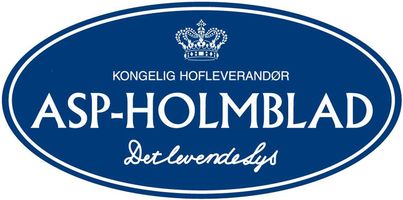The story of the candlelight
Candles are the epitome of coziness
and a good atmosphere. ASP-HOLMBLAD A/S has been a supplier of candles for a good atmosphere since 1777.
The story began back in 1777, when Jacob Holmblad set up his own factory in Copenhagen, where he made candles from marvole, bone glue and other smelly animal products in a steady stream. In 1841, a distillery was built on Holmbladsgade on Amager.
In Christianshavn, there was a soap and lamp oil factory, O.F Asp, which also made candles. Throughout the 19th century, the two factories were competitors until they merged in 1919.
When the Danes put candles in their windows on May 4, 1945, they revived an old expression of celebration and joy. For centuries, Copenhageners had illuminated the city on the royal family's feast days with glass lamps, colored wax candles and tall candles in the windows, and many court celebrations ended with the party driving around the city to see the lights.
When Christian IX and Louise celebrated their golden wedding anniversary in 1892, the first ever in the history of the royal family, all of Copenhagen was lit by candles; electricity had just arrived in Copenhagen, but not many homes had it installed.
In 1907, ASP-HOLMBLAD A/S was awarded the title Royal Court Supplier.
For generations, ASP-HOLMBLAD A/S has supplied lights for holidays and celebrations of life. Back in the day, they also manufactured carriage lights, carriage lights and lights for bicycle lights so that people could travel safely through the darkness.
The Advent wreath originated in Germany and the first Advent wreath was lit at Fredensborg Castle in 1918, where ASP-HOLMBLAD A/S launched Advent candles.
In 1942, ASP-HOLMBLAD launched the Jakobs lyset, which today is what we know as the calendar candle. The Jakobs lyset refers to the Bible, where the angels climb Jacob's ladder, but when the population was no longer so biblically strong, the name was changed to calendar candles. Calendar candles No. 1, which was launched in 1942, still looks the same today as it did when it was launched.
The Christmas tree candle is also one of the old classics with a long history. Like the Advent wreath, the Christmas tree also comes from Germany and the tradition of candlelight on the Christmas tree has been known since the early 1800s.
Until World War II, the majority of candles sold were white candlesticks, but throughout the 1950s ASP-HOLMBLAD launched colored candles and candles in various shapes.
In the early 1970s, the block candle was introduced. Later, the product tealight candles were added, and today they are the largest segment on the Danish market in the candle category.
ASP-HOLMBLAD A/S has most recently launched tealight candles and block candles in pure stearin. In the future, ASP-HOLMBLAD will continue to develop candle products in pure stearin. Stearin is the most climate-friendly raw material when talking about candles, as stearin releases less CO2 into the atmosphere than candles made from, among other things, paraffin, which is derived from oil and is therefore a fossil fuel that has a high CO2 emission.
We all need to think about the climate, so if you want to choose climate-friendly candles, buy candles made from 100% stearin. They contribute to a better climate with less CO2 in the atmosphere when you create a good atmosphere with candles for everyday coziness and celebrations.


